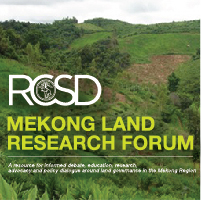Location
The purpose of the Mekong Land Research Forum online site is to provide structured access to published and unpublished research on land issues in the Mekong Region. It is based on the premise that debates and decisions around land governance can be enhanced by drawing on the considerable volume of research, documented experience and action-based reflection that is available. The online site seeks to organise the combined work of many researchers, practitioners and policy advocates around key themes relevant to the land security, and hence well-being, of smallholders in Cambodia, Laos, Myanmar, Thailand and Vietnam.
The research material on this site is mounted at three levels:
First, a selection of journal articles, reports and other materials is provided and organised thematically to assist researchers, practitioners and policy advocates to draw on one another’s work and hence build up a collective body of knowledge. This is the most “passive” presentation of the research material; our contribution is to find and select the most relevant material and to organise it into key themes. In some cases the entire article is available. In others, for copyright reasons, only an abstract or summary is available and users will need to access documents through the relevant journal or organisation.
Second, a sub-set of the articles has been annotated, with overall commentary on the significance of the article and the research on which it is based, plus commentary relevant to each of the key themes addressed by the article.
Third, the findings and key messages of the annotated articles are synthesised into summaries of each of fourteen key themes. For each key theme, there is a one-page overall summary. Extended summaries are being developed progressively for each theme as part of the Forum's ongoing activity.
Overall, we intend that this online site will contribute toward evidence-based progressive policy reform in the key area of land governance. We further hope that it will thereby contribute toward to the well-being of the rural poor, ethnic minorities and women in particular, who face disadvantage in making a living as a result of insecure land tenure.
Members:
Resources
Displaying 171 - 175 of 564Forest policy measures influence on the increase of forest cover in northern Laos
The government of the Lao People’s Democratic Republic has made great efforts to halt the rapid decline in forest cover by implementing different policy measures, which include measures: to address the causes of the decline in forest cover; to sustainably manage natural forests; and to regenerate degraded forests. In the last decade, forest cover has continued to decrease at a lower rate of just 1% from 2002 (41.5%) to 2010 (40.3%) at national level; however, there has been a net gain of forests in the northern region.
Land concessions and rural youth in southern Laos
Scholars have produced valuable insights on the question of recent “land grabbing” in the global South. They have, however, insufficiently studied the issue from below, particularly from the point of view of a crucial group in the land conundrum: the rural youth. This paper brings to the fore the perspectives of Laotian rural youngsters amidst a hasty agrarian transition, in which the borisat (company) –in the form of large monoculture plantations– has permeated both the physical landscape and the daily narratives of people.
Land deals in Laos: First insights from a new nationwide initiative to assess the quality of investments in land
In Laos land concessions have increased dramatically over the last decade. To provide a window into the concessions landscape, we conducted a nationwide inventory between 2007 and 2011. In response to an order by the Lao Government to its ministries, we developed a methodology to update the inventory and complement existing data with a systematic assessment of investment quality in 2014. We investigated aspects of compliance as well as impacts on livelihoods and the environment.
Allocation or appropriation? How spatial and temporal fragmentation of land allocation policies facilitates land grabbing in Northern Laos
The Lao Land and Forest Allocation Policy (LFAP) was intended to provide clearer property rights for swidden farmers living in mountainous areas. These lands are legally defined as “State” forests but are under various forms of customary tenure. The policy involves demarcating village territorial boundaries, ecological zoning of lands within village territories, and finally allocating a limited number of individual land parcels to specific households for farming.
Authoritarian resource governance and emerging peasant resistance in the context of Sino-Vietnamese Tree Plantations, Southeastern Laos
Over the past decade, Laos has experienced a land rush by foreign investors seeking to gain large tracts of land for hydropower, mining, and plantation projects. The rapid pace of the phenomenon has prompted signif icant concern by international observers, Lao civil society, and certain sections of the government, regarding the impacts upon farmers that are dispossessed of their land and communal resources. However, both investors and peasant communities alike have differing experiences with the investment process.


